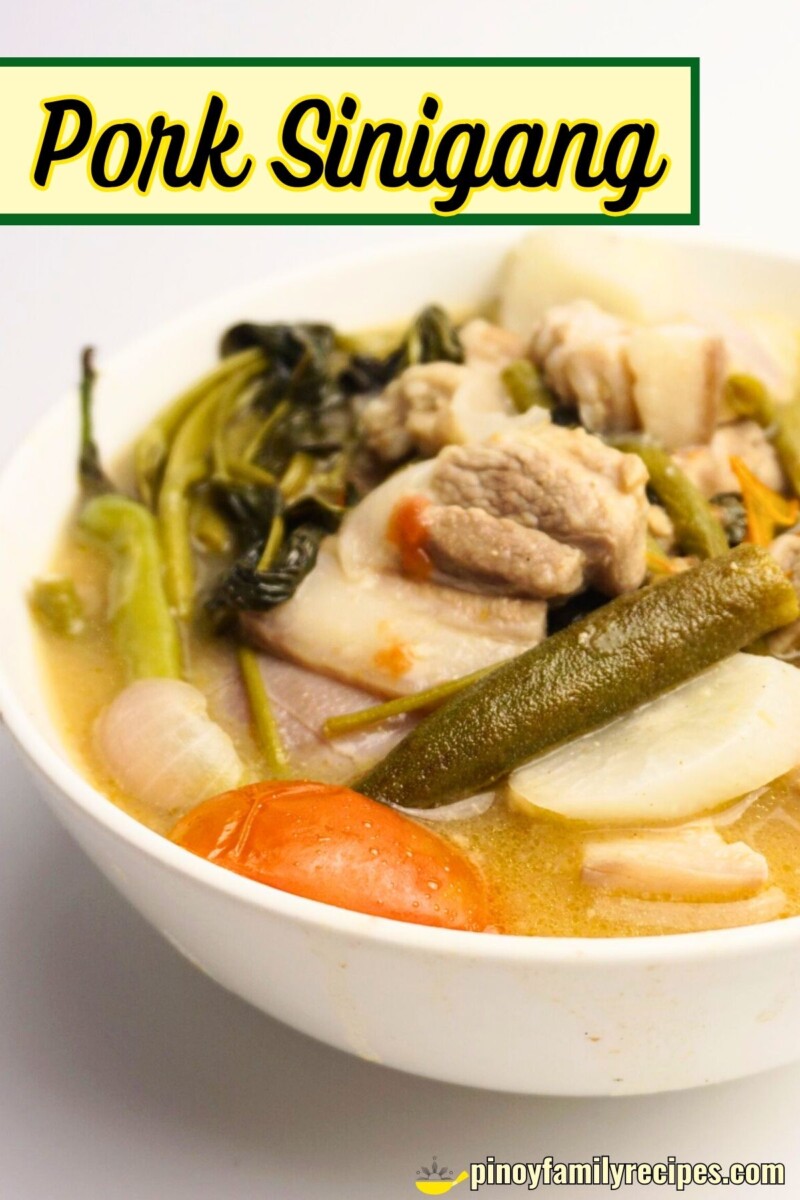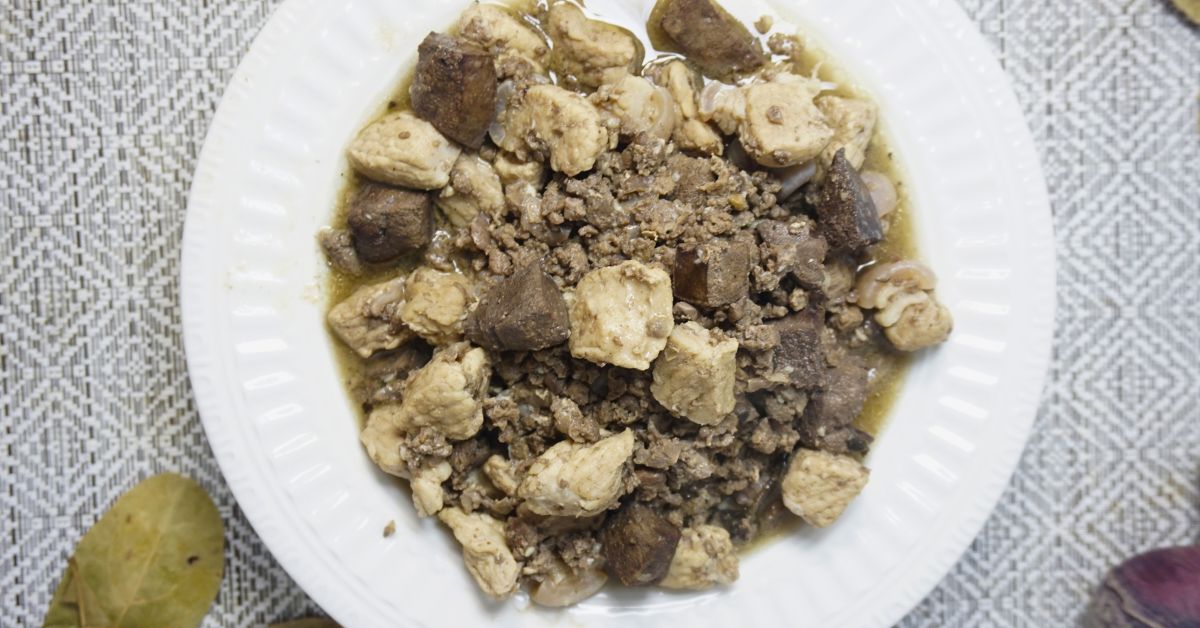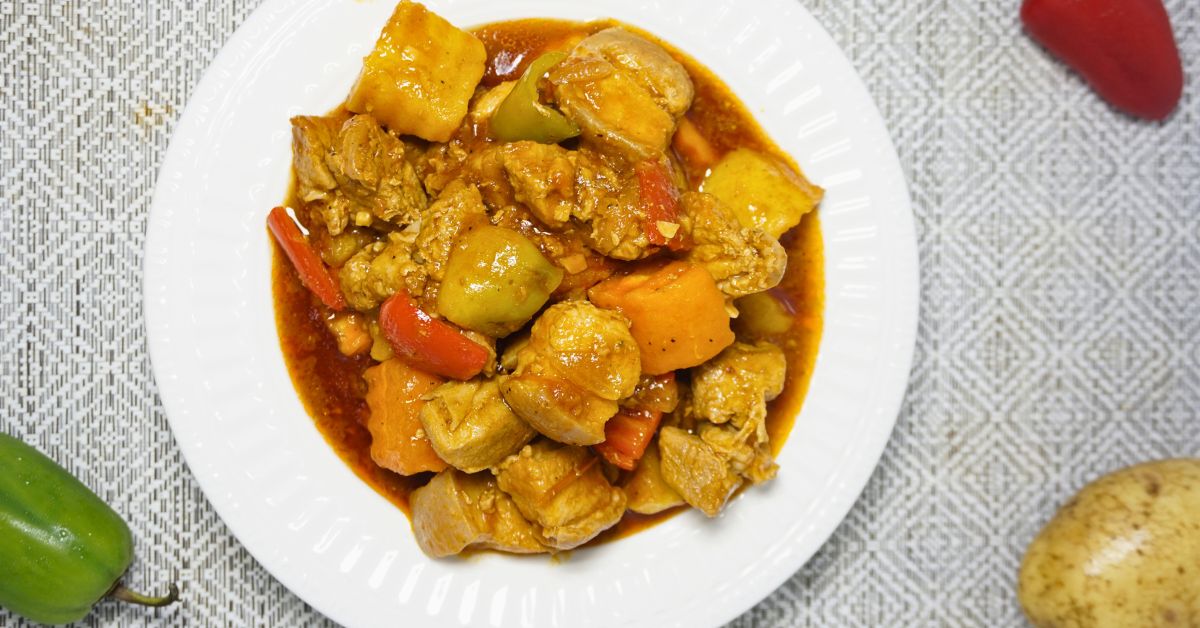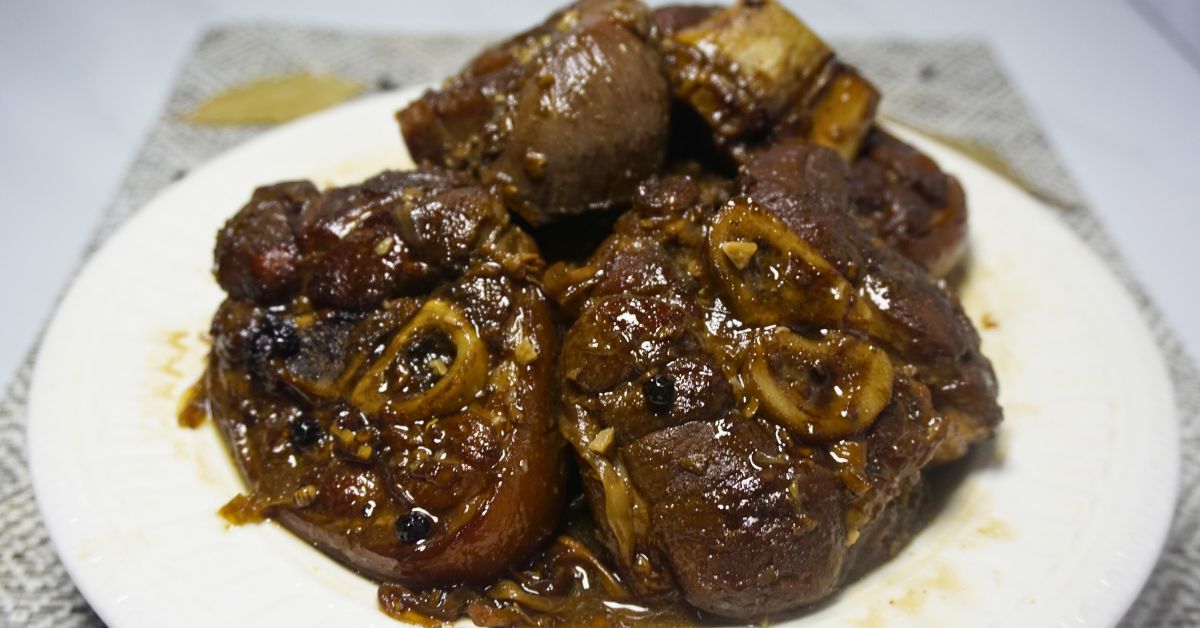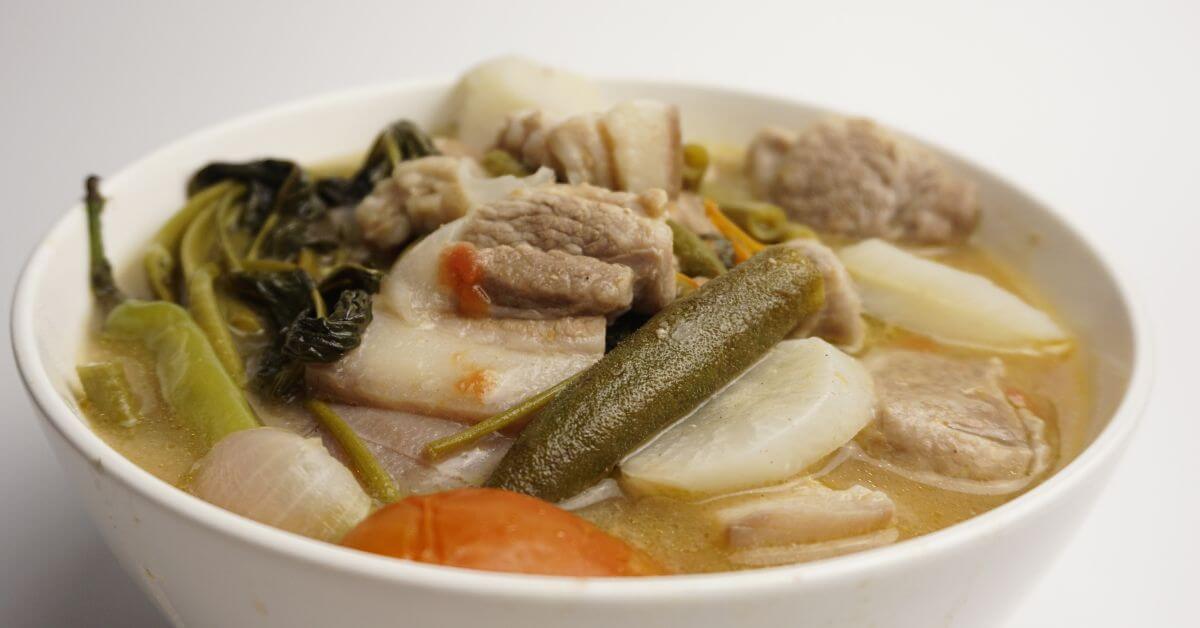
A hot bowl of Pork Sinigang feels like a warm hug, especially on lazy Saturdays. Rain or shine, my family always craves this sour soup, especially with tasty pork.
Packed with vegetables like juicy tomatoes, tender radishes, and crisp green beans, Pork Sinigang offers a delightful blend of flavors and textures.
The tangy broth, infused with tamarind and a hint of fish sauce, provides a comforting kick that warms both body and soul. The “asim kilig” sensation, a mix of sourness and excitement, dances on your taste buds with each spoonful.
I know you’re already mouthwatering, so join me as I share with you the simple steps to create this irresistible dish that will surely become a favorite in your home!

Why Do Filipinos Love To Eat Sinigang?
As a Filipino, I absolutely adore Sinigang, and there are a few reasons why it holds such a special place in my heart—and my stomach!
Firstly, there’s something incredibly comforting about the tangy sourness of Sinigang’s broth. Whether it’s a scorching hot day or a rainy afternoon, that zesty flavor instantly perks up my taste buds and brings a sense of refreshment.
I also love how versatile Sinigang is. I can make it with pork, shrimp, fish, or even beef, depending on what’s available or what I’m in the mood for. Plus, it’s a fantastic way to use up whatever veggies are sitting in my fridge—tomatoes, radishes, string beans—they all work beautifully in Sinigang
And most of all, it is so easy to cook. It’s one of those dishes that makes me feel like a kitchen superstar, even on my most “learning as I go” days.
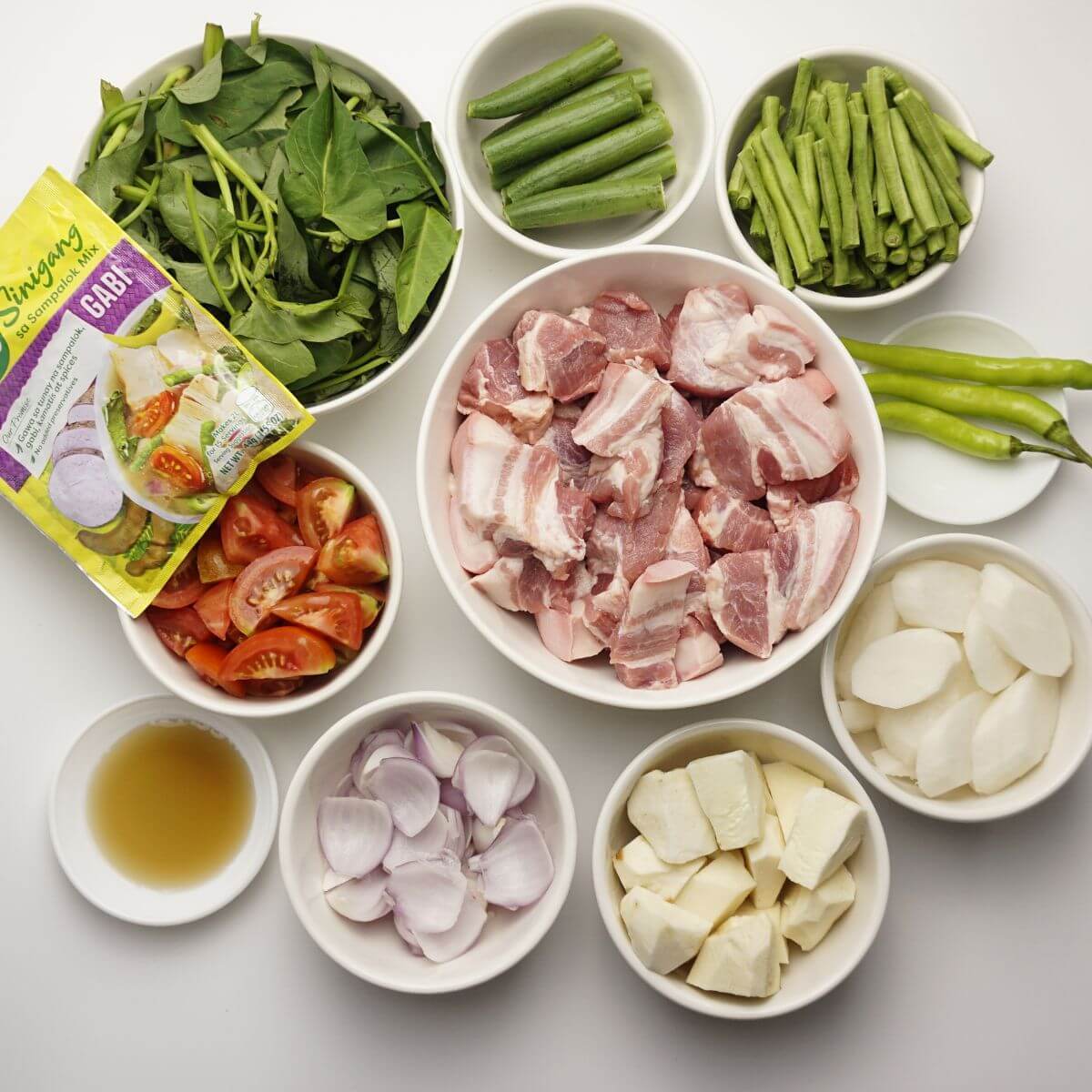
What is Pork Sinigang Made of?
- Pork: We’re talking pork belly or ribs here, but feel free to use your favorite cut. Pork belly is what I am using here, it’s my go to part when cooking pork sinigang. I would often mix “buto-buto” to make it more flavorful.
- Vegetables:Think tomatoes, radishes, string beans, eggplant(optional), and kangkong. You can mix it up based on what you like or have on hand.
- Tamarind: This is what gives Sinigang its signature tang. You can use fresh tamarind, tamarind paste, or powdered tamarind mix.
- Fish sauce: These add a savory depth to the broth. Don’t skip ’em!
- Flavor Boosters: Garlic, onions, and green chili These guys bring out the best in the broth.
- Liquid: Water or broth will be our base for the soup.
- Seasonings: Just a sprinkle of salt and pepper to taste.

How To Cook Sinigang?
Sauté Onion and Tomatoes
Heat a casserole over medium heat and sauté onion and tomatoes until tender, allowing their flavors to meld and create a savory base for the sinigang.
Sear Pork
Add the pork to the casserole with the sautéed tomatoes and onion, searing it until it develops a golden-brown color, enhancing its flavor and texture.
Add Taro and Fish Sauce
Mix in the taro and fish sauce, allowing them to infuse the dish with their earthy and savory notes, complementing the tanginess of the broth. time! Pour in a good amount. This gives the adobo that awesome tangy kick. Let it cook a bit more – you’re almost there!
Pour Water and Boil
Pour four cups of water into the casserole, bringing it to a vigorous boil before reducing the heat to a gentle simmer, ensuring the pork becomes tender and flavorful.
Add the Sinigang Mix
Sprinkle the sinigang mix into the pot, stirring it thoroughly to dissolve and distribute its tangy and sour flavors evenly throughout the broth.
If Using Fresh Tamarind:
When using fresh tamarind for your Sinigang, start by boiling the tamarind in a separate pot for about 10-15 minutes. Once softened, mash the pulp against the pot’s side to release its juices. Strain the mixture through a sieve to separate the pulp from the seeds and fibers, collecting the tamarind juice in a bowl. Finally, add the strained tamarind juice to your Sinigang broth according to your taste preferences, adjusting the amount for desired sourness. This method ensures your Pork Sinigang is infused with the fresh, tangy flavor of tamarind, enhancing its overall taste and authenticity.
Add the Vegetables
Add the okra, string beans, and radish to the simmering broth, allowing them to cook until tender, infusing the sinigang with their vibrant colors and fresh taste.
Final Touches
Toss the kangkong and green chilis to the pot, seasoning with salt to taste, and boiling for an additional five minutes to marry all the flavors together.
Serve
Transfer the Pork Sinigang into bowls, ensuring to ladle in plenty of broth and a generous portion of tender pork and vegetables, ready to be enjoyed piping hot.

Other Fruits You Can Use for Sour Soup in Sinigang
Green mango
Unripe green mangoes provide a tartness that works well in sour soups like Sinigang. They also add a unique fruity flavor to the dish, enhancing its overall freshness.
Kamias
This tropical fruit has a sour taste similar to tamarind and can be used as a souring agent in Sinigang for a slightly different flavor profile, adding depth and complexity to the soup.
Santol
While less common, santol can be used to add a sour and slightly sweet flavor to Sinigang. It’s important to remove the seeds and pulp before using it in the soup, ensuring a smooth texture and pure sourness.
Guava
Guava adds a tropical sweetness and tartness to Sinigang, creating a unique twist on the traditional recipe, infusing the soup with a delightful fruity aroma and flavor. But when we use guava as a substitute, we will call it bulanglang instead.

How To Serve and Store
When serving Pork Sinigang, scoop it into bowls, making sure each serving has a good mix of pork, veggies, and broth. It’s delicious with steamed rice or as a standalone soup.
To store leftovers, let the Sinigang cool down first. Then, transfer it to a sealed container and pop it in the fridge—it’ll stay fresh for 3-4 days.
When you’re ready to eat again, gently reheat it on the stove or in the microwave until it’s nice and warm. Just remember to stir it every so often for even heating. Enjoy your Sinigang while it’s still fresh and tasty!
Frequently Asked Questions
If the Sinigang is too sour, you can balance it by adding more water, vegetables, or a little sugar. You can also adjust the sourness by adding less tamarind or souring agent next time you cook it.
Yes, Sinigang can be made with other meats such as beef (Sinigang na Baka), shrimp (Sinigang na Hipon), or fish (Sinigang na Isda). The preparation method remains similar, with adjustments in cooking time depending on the type of meat used.
Sinigang can be a healthy dish as it is rich in vegetables and lean pork. The soup base is usually low in fat and calories. However, the healthiness can depend on the cut of pork used and the amount of fish sauce added, as it is high in sodium.
Yes, you can freeze Pork Sinigang. Allow it to cool completely before transferring it to airtight containers or freezer bags. It can be stored in the freezer for up to 3 months. Thaw in the refrigerator overnight and reheat on the stove before serving.

Pork Sinigang
Ingredients
- 2 tbsp Oil
- 1 piece Onion large (squared)
- 4 pieces Tomato large (squared)
- 1 Kilogram Pork Belly (square slices)
- 4 pieces Taro/Gabi (sliced into four)
- 2 tbsp Fish Sauce
- 4 cups Water
- 1 sachet Sinigang Mix
- 8 pieces Okra
- 1 bunch String Beans (cut to 3 inch length)
- 1 piece Radish (sliced)
- 1 bunch Kangkong (cut to 3 inch length)
- 3 pieces Green Chili
- Salt to taste
Instructions
- Heat the oil in a large pot over medium heat. Sauté the onion until translucent. Add the tomatoes and cook until they begin to soften.
- Add the pork belly to the pot and cook until lightly browned.
- Add the taro (gabi) and stir in the fish sauce. Simmer for about 15 minutes.
- Pour in the water and bring to a boil.
- When the pork is slightly tender, add in the Sinigang Mix.
- Add the okra, string beans, and radish. Simmer for another 5-7 minutes until vegetables are tender but still crisp.
- Stir in the kangkong stalks and green chili peppers. Cook for an additional 2 minutes until the kangkong stalks are tender.
- Taste and adjust the seasoning with salt if needed. Serve hot with steamed rice.
Video
Notes
- Sinigang is traditionally served with fish sauce (patis) and calamansi or lemon on the side for added flavor.
- Adjust the amount of sinigang mix according to your preferred sourness level.
- Cooking times may vary depending on the size and thickness of the pork belly and vegetables.


